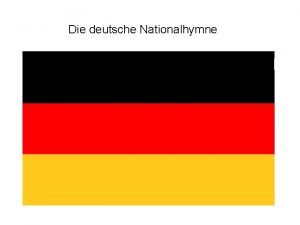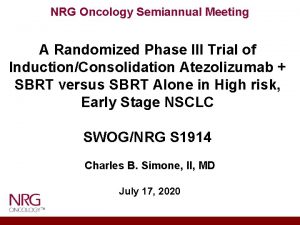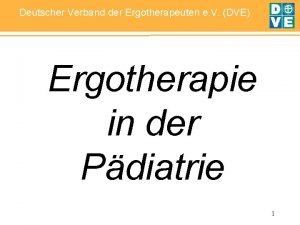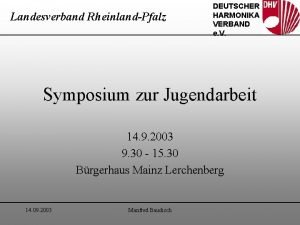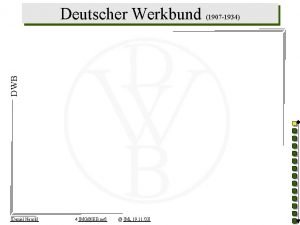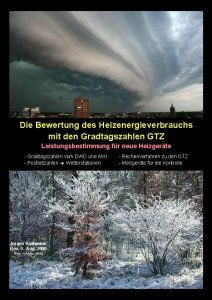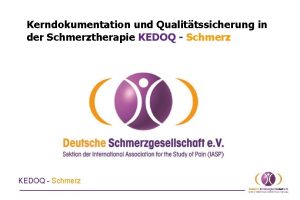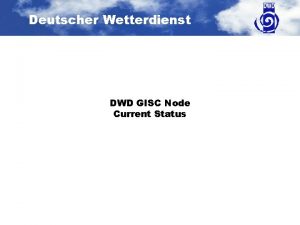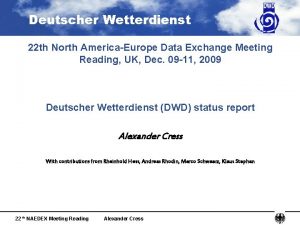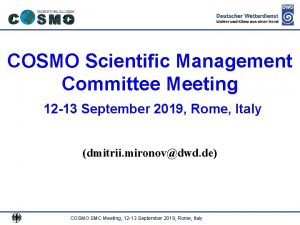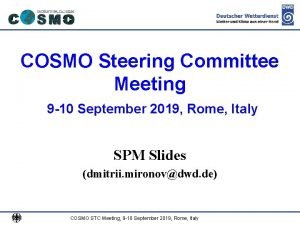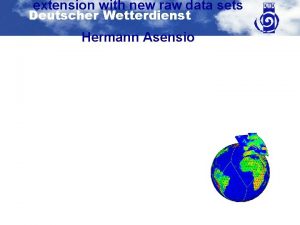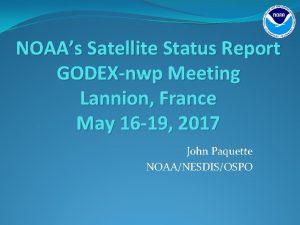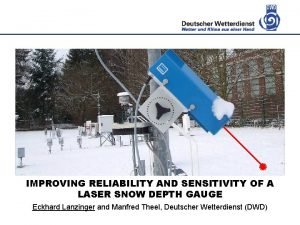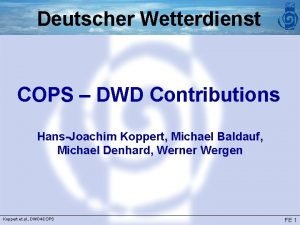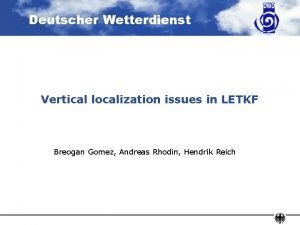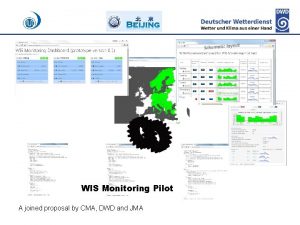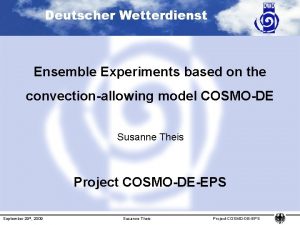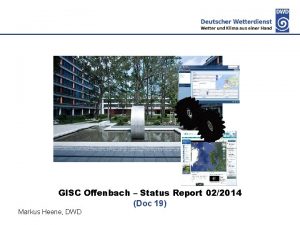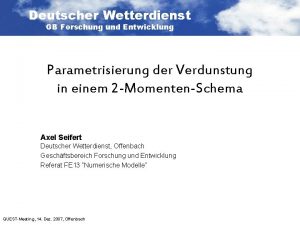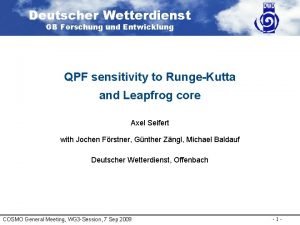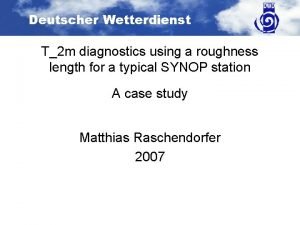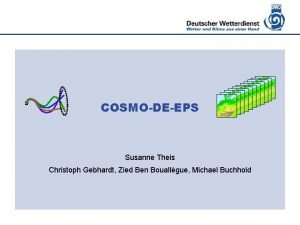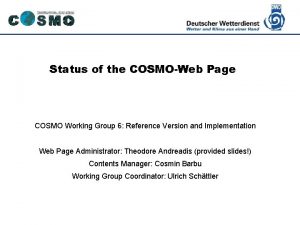GODEX Data Exchange Meeting Lannion 2017 Deutscher Wetterdienst




















- Slides: 20

GODEX Data Exchange Meeting (Lannion 2017) Deutscher Wetterdienst (DWD) status report Alexander Cress Deutscher Wetterdienst, Frankfurter Strasse 135, 6003 Offenbach am Main, Germany alexander. cress@dwd. de and Robin Faulwetter, Olaf Stiller, Anne Walter, Stefanie Holbrook, Michael Bender. Andreas Rhodin, Harald Anlauf, Christina Köpken-Watts, Kirstin Raykova, Axel Hutt etc… GODEX Meeting Alexander Cress Lannion 2017

The deterministic NWP-System of DWD Global-Modell ICON-EU Nest over Europe COSMO-DE (convection grid size: 13 km vertical levels: 90 Grid area: 173 km 2 grid size: 6. 5 km Vertical levels: 60 forecasts: Grid area: 43 km 2 resolving) Hybrid DA • • grid size: 2. 8 km vertical levels: 50 forecasts: 3 -hourly Girid area: 8 km 2 Det LETKF replace nudging 13 km Var. En. KF Flow dependent B: BVar. En. KF = αBLETKF + (α-1)B 3 DVAR Incremental analysis update SST, SMA and snow ana GODEX Meeting Alexander Cress Lannion 2017

The probabilistic NWP-System of DWD ICON-EPS; M 40 ICON-EU Nest over Europe COSMO-DE-EPS; M 20 grid size: 40 km vertical levels: 90 grid area: 1638 km 2 grid size: 20 km vertical levels: 60 forecasts: grid area: 407 km 2 grid size: 2. 8 km vertical levels: 50 Forecasts: 3 -hourly grid area: 8 km 2 Ensemble DA • • • 40 member 40 km LETKF. Horizontal localization radius 300 km. Relaxation to prior perturbations ( 0. 75). Adaptive inflation (0. 9 - 1. 5). SST perturbations Soil moisture perturbations (experimental) Ensemble DA 40 member 2. 8 km LETKF SST pertubations Soil moisture pertubations

Satellite data usage Microwave and infrared instruments Obs. System Satellite Channels Remarks AMSU/A NOAA 15 NOAA 18 NOAA 19 METOP-A/B 5 -14 RTTOV 10 over sea and high peaking channels over clouds and land AMSU/B MHS NOAA 19 METOP-A/B 3 -5 Only over sea ATMS NPP 6 -15 Over sea and high peaking channels over clouds and land SSIM/S F-16, F-17, F 18 4 channels Monitoring, first experimets end 2017 AMSR-2 GCOM-W 1 4 channels Monitoring, first experimets end 2017 GMI GPM 4 channels Monitoring, first experiments end 2017 SAPHIR Megha-Tropiques IASI METOP-A/B ~50 infrared channels 16 humidity channesl over sea and high peaking channels over clouds and land Cris NPP ~50 channels Monitoring and first assimilation experi. MWTS-2/MWHS-2 FY-3 C GODEX Meeting Monitoring Alexander Cress Lannion 2017

Satellite data usage Microwave and infrared instruments Obs. System Satellite Channels Remarks Radioccultation Cosmic, Grace, Gras, Terra. Sar, Tandem-X Upper troposhere and stratosphere Observation operator; own development AMV NOAA 13/15, Meteosat 8/10, MTSAT-2, MODIS, NOAA series and Metop, NPP/VIIRS, Himawari-8, Insat-3 FY-2 G, COMs Infrared, visible and wv Over sea and partly over land. Qi threshold Scatterometer ASCAT on Metop-A/B Altimetry Jason-2, Jason-3, Saral Wind speed Over sea used since beginning of 2017 Geostationary radiances Meteosat Seviri All-sky WV channels First experiments in regional model GODEX Meeting Sea only Alexander Cress Lannion 2017

New developments since last meeting Global scale § Global ICON Ensemble DA system operational Jan. 2016 § Global hybrid 3 dvar (ENVAR) operational since Jan. 2016 § Use of 16 humidity sensitve channels since 2017 § Microwave imager radiance data received and monitored § NPP/VIIRS, HIMAWARI-8 and Meteosat 8 AMVs operational § Global Metop A/B pre-operational § Wind speed observations from altimetry (Janson 2/3, Saral) operational § Radiosondes in Bufr format (including drifting) operational § selected Synop, Ship and Buoys in bufr format § Monitoring of Vaisala RS 41 descenting data § Pre-operational use of GNSS data § Use of sea ice concentration on great lakes operationally

New developments since last meeting Local scale § LETKF for local model COSMO-DE operational § Use of doppler radar wind data and reflectivities § Use of Meteosat 10 Seviri CSR WV chanels (experimental) § selected radiosonde bufr data operational § selected Synop, Ship and Buoies bufr data operational § Pre-operational use of GNSS (ZTD and STD) data § Pre-operational use of MODE-S data § Aircraft temperature bias correction implemented

Use of humidity-sensitive IASI channels Exp. – Crtl. Ø Use of 50 temperature-sensitive IASI channels operationally Ø Use of MHS data operationally Ø Addional use of 16 humitidy-sensitive IASI channels Ø Plus reduced thinning (200 km -> 120 km) of three MHS channels Crtl: No use of IASI humidity channels and reduced thinning One Month in May 2016 / full ensemble Experiment is drier than Crtl Experiment is wetter than Crtl

Assimilation cycle Obs minus FG comparison Radiosonde statistics (globally) Temporal average: 08. 05. 2016 - 31. 05. 2016 Relative Humidity Crtl Experiment Temperatur Ø Humidity bias slightly increased but error reduced Ø No systematic change in temperature bias or standard deviation Ø No of used radisondes slightly increased

Forecast impact 00 UTC forecasts against own analysis - tropics

Assimilation of microwave imagers GMI on GMP 36. 5 GHz V SSMI/S on DMSP-F 17 37. 0 GHz V stddev (obs – fg) mean (obs – fg) AMSR 2 on GCOM 36. 5 GHz V Preparation for assimilating microwave imagers (19 GHz, 24 GHz, 37 GHz, 89 GHz) in clear sky situations over sea • bias correction and sea ice detection (strong dependence on surface emissivity) • exclusion of scattering situations (cloud detection) • Assimilation experiments planned for autuum/winter 2017

Assimilation of IR radiances over Deutscher Wetterdienst land (Kristin Raykova) • Goal: Assimilation of IR radiances – coming from IASI and Cr. IS – over land in the window zone (10 -14 μm). • Biggest challenges: finding cloud-free FOVs with high confidence and making a reliable estimation of the surface emissivity and skin temperature and their corresponding errors. Current status: modifying and the operational cloud detection scheme based on Mc. Nally and Watts, in order to obtain cloudfree FOVs of low-peaking channels over land with high certainty. Especially over land ist MNW very conservative and flags almost all FOVs as cloudy.

Monitoring of surface emissivity • Brightness temperature of IASI window channel 646 (peak ~ 1 km) (01. 05. 2016 – 31. 05. 2016) Oak leaf Sand sample Absolute difference of Obs-FG (trial vs. control) Exp. with emissivity atlas – Exp. without atlas (fixed Value of 0. 97) • Improvement especially over regions with strongly varying emissivity spectrum.

Use of PC compressed IASI radiances • use of reconstructed radiances (Rec. Rad) based on IASI principal component scores product by EUMETSAT (NWP SAF) • Technical implementation finished, first experiment started GPSRO IASI • Assimilation of Rec. Rad with ICON-En. Var experiments seems promising regarding to noise reduction under information maintenance (see plots IASI) • Comparison Rec. Rad – Ref (Raw. Rad): neutral or slyightly positive impact on OBSFG of other observation systems (see plots GPSRO) • Outlook: Routine monitoring of IASI PC datasets from EUMETSAT (NWP SAF) GODEX Data Exchange Meeting Alexander Cress contact: silke. may@dwd. de Lannion 2017

All-sky data assimilation of SEVIRI WV channel data in regional area • Kilometer-scale ensemble data assimilation (KENDA) • Aim : DA taking into account cloudy observations radiosonde statistics humidity • Method: • identification of clear and cloudy observations • clear sky : small observation error cloudy: large observation error • First results: improved first guess departure for • clear-sky data • thinning in preprocessing • Assimilation experiments started number of obs

Use of Atmospheric vector winds q Operational use of HIMAWAR-8 winds q NPP/VIIRS winds became operational q Meteosat 7 AMVs replaced by Meteosat 8 winds operationally q Monitoring of several additional AMVs from q China (FY-2 G) q Korea (COMS) q India (INSAT 3) q Metosat 11 (Test data set) q new polar Metop winds (three images instead of two) q leo/geo winds from CIMSS q Wind speed dependent bias correction for scatterometer and altimeter q Operational use of Jason 2/3 and Saral altimeter wind speed data q Use CALIPSO cloud heights to derive weekly/monthly correction functions for AMV heights 16/63

GNSS Zenit/Slant Total Delay (ZTD/STD) Michael Bender (DWD/IAFE) § GNSS (GPS) Slant Path Delay: humidity integrated over path from ground station to GNSS (GPS) satellite, all weather obs § Many stations => 3 D information on humidity, but § STDs are vert. + horiz. non local data (no point measurements). Localisation problematic § Observation Operator works for ZTDs and STDs, globally and regionally (part of COSMO Code) § Single site bias correction developed § Whitelist for processing center selection created § First global (ZTD) and regional (STD) assimilation and forecast experiments started

Global ZTD assimilation and forecast experiment

KENDA-O overview, Task 2 (high-res. obs): GPS-STD, first trial for use in KENDA 8 days 17 – 24 Mai 2014 1 -h precip 0 -UTC 6 -UTC runs 12 -UTC 18 -UTC runs FSS (30 km) 1 mm/h CONV only CONV + GNSS CONV + LHN = Ref CONV + LHN + STD ü 1 mm/h : slightly better for 0 -, 6 -, 18 -UTC runs

Thank you for your attention! APSDEU-12/NAEDEX-24 Data Exchange Meeting Alexander Cress Questions?
 Originaltext deutsche nationalhymne
Originaltext deutsche nationalhymne Joanne chien
Joanne chien Nrg oncology semi annual meeting 2018
Nrg oncology semi annual meeting 2018 Job meeting bari 2017
Job meeting bari 2017 Nrg oncology meeting 2016
Nrg oncology meeting 2016 Nrg oncology meeting 2019
Nrg oncology meeting 2019 American epilepsy society annual meeting 2017
American epilepsy society annual meeting 2017 Erfinderin des kaffeefilters
Erfinderin des kaffeefilters Betätigungsanalyse ergotherapie
Betätigungsanalyse ergotherapie Manfred baudisch rostock
Manfred baudisch rostock Daniel nauck
Daniel nauck Drafi deutscher maria
Drafi deutscher maria Personalwirtschaftspreis
Personalwirtschaftspreis Webmaschine industrialisierung
Webmaschine industrialisierung Deutscher basketball bund regeln
Deutscher basketball bund regeln Gradtagszahlen 2020 tabelle iwu
Gradtagszahlen 2020 tabelle iwu Deutscher aberglaube
Deutscher aberglaube Bundesverbandes deutscher gartenfreunde
Bundesverbandes deutscher gartenfreunde Deutscher schmerzfragebogen muster
Deutscher schmerzfragebogen muster Deutscher gründerpreis für schüler aufgaben
Deutscher gründerpreis für schüler aufgaben Personalausweis satan
Personalausweis satan
